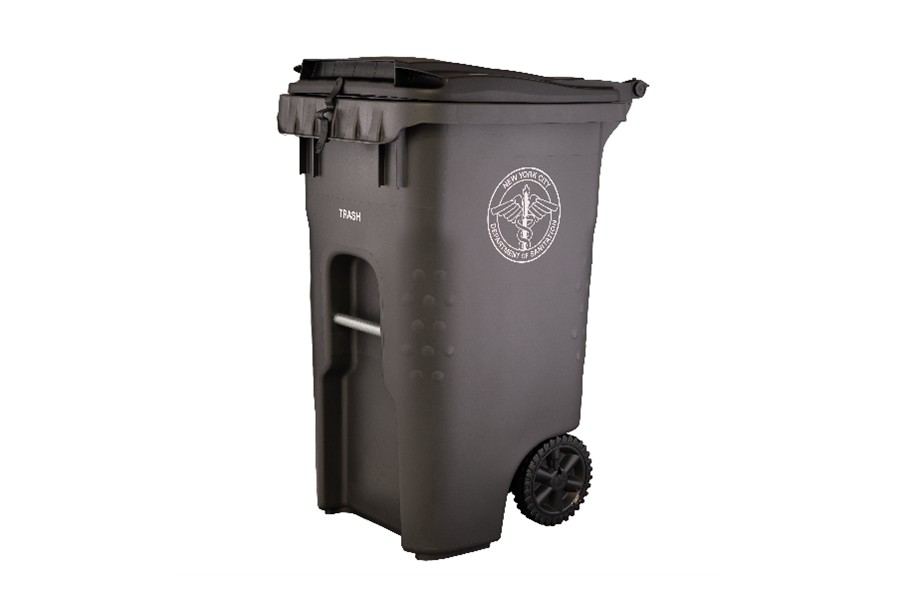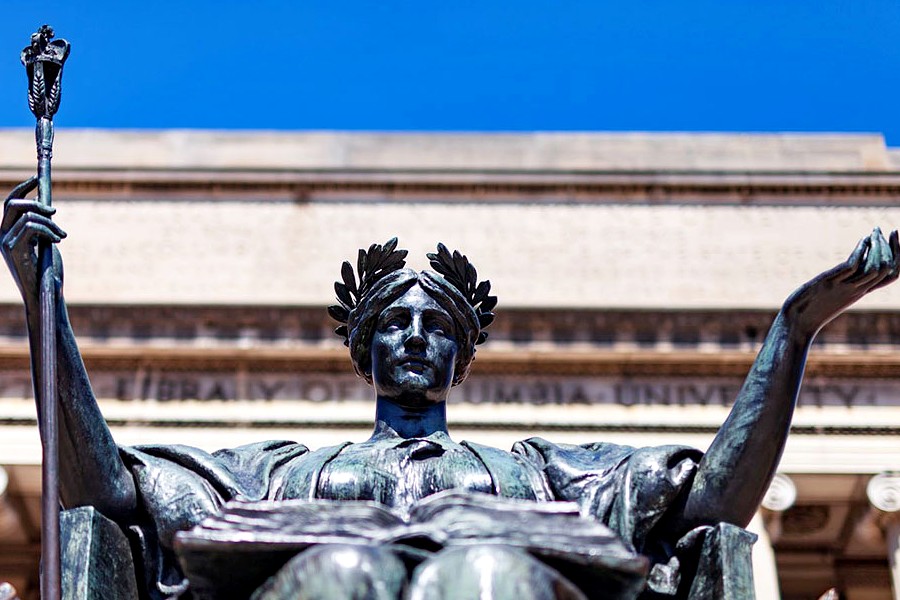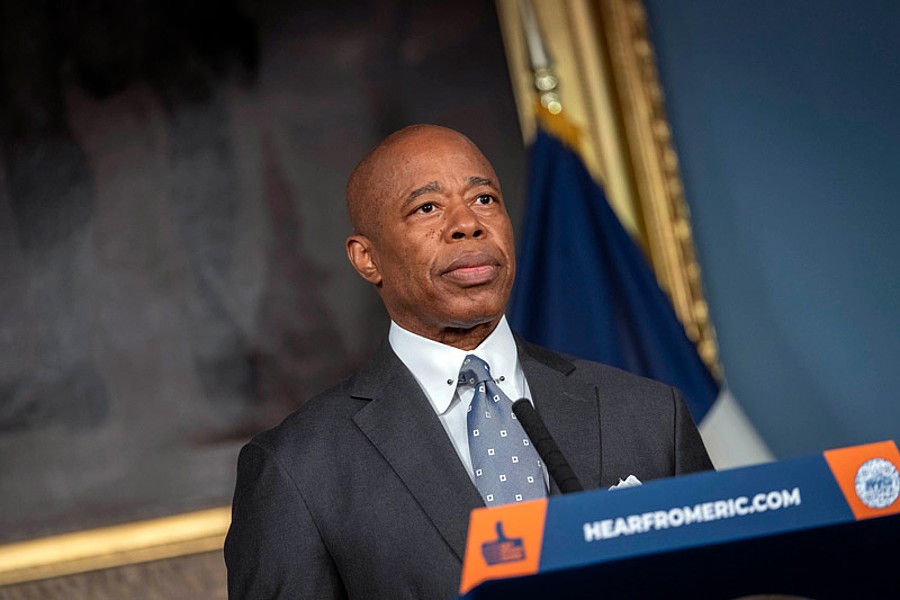
NYC Mayor Eric Adams and NYC Department of Sanitation (DSNY) Commissioner Jessica Tisch today symbolically set Gracie Mansion’s trash and recycling out at the curb.
Marking the next step in relegating New York City’s once-omnipresent mountains of black trash bags to the dust bin of history. This waste was the first to be set out in the first-ever official NYC Bin, now available online. The new official NYC Bin is equipped with wheels and a secure latching lid, and is the cheapest bin of its quality available, with prices below $50 for the most common size. Additionally, Mayor Adams today also announced that DSNY has put forth a proposed rule requiring that all buildings with one to nine residential units and all special use buildings that receive DSNY collection (e.g. city agency buildings, houses of worship, and professional offices located within residential buildings) put their trash in containers, effective November 12, 2024.
“Today, we are tossing even more black bags into the dustbin of history and taking the next step forward in our ‘Trash Revolution,’” said Mayor Adams. “The first-ever, official NYC Bin is high-quality, affordable, and will build on our efforts containerizing more than 70 percent of the city’s trash to protect our most valuable and limited resource — our public space.”
“NYC-branded wheeled containers, custom designed to work with our trucks, are the key to keeping our most precious real estate — New York City sidewalks — clear,” said Deputy Mayor for Operations Meera Joshi. “With over 70 percent of New York City’s trash contained, the Adams administration and the hardworking men and women of DSNY are defying the odds and the naysayers and winning the ‘Trash Revolution.’”
“Many property owners already use bins for their trash — and pay over $100 retail in order to keep the streets clean,” said DSNY Commissioner Tisch. “Well, we’ve got great news: at the same time that we’re moving to require containerization of trash for all buildings with one to nine residential units, we’re unveiling the official ‘NYC Bin’ — beautiful, durable, and less than $50 for the most common size.”
The new official NYC Bin is the cheapest bin of its quality available; similarly durable bins with wheels and a secure, latching lid are sold in retail stores for almost three times the price. These savings were achieved through an innovative contracting mechanism in which one vendor is held to a low price in exchange for exclusivity.
Many lower-density residential buildings and special-use buildings already use bins to set out their trash, and the rule provides a period of more than 18 months during which they may continue to use bins they already have, provided those bins are 55 gallons or less and have a latching lid to keep rats out. Thanks to this program, replacing those bins when they wear out just became vastly more affordable, significantly reducing costs for small property owners.
Effective June 1, 2026, those buildings will be required to use the official NYC Bin to facilitate faster, safer, cleaner mechanized collection with rear-loading “tipper” garbage trucks. Any property owner or manager covered by the rule who does not currently have a bin is encouraged to purchase the official NYC Bin, as this bin is far cheaper than anything of its quality sold in retail stores. While the requirements of this new rule only cover trash and compostable material, matching green (paper) and blue (metal, glass, plastic, cartons) NYC Bins are also available for purchase for any property owner or manager who prefers a matched set. Bins should be ordered by October 1 to guarantee delivery before the new containerization requirement goes into effect on November 12.
Implementation of the rule will include a warning period extending through the end of 2024, with issuance of fines to commence on January 2, 2025. As with existing commercial containerization requirements, the fine for leaving trash on New York City streets rather than in a secure bin of 55 gallons or less is $50 for a first offense, $100 for a second offense, and $200 for a third offense and each thereafter. DSNY will engage in substantial outreach this summer around these new rules, including through mailers, door to door canvassing, community and ethnic media outreach, and work with community boards and civic associations.
The “Trash Revolution” Thus Far
The launch of pre-orders for the official NYC Bin and the rule mandating low-density containerization are the latest steps in the rapid rethinking of the relationship between 8.3 million New Yorkers and 14 billion annual pounds of trash — an undertaking collectively known as the “Trash Revolution” — that has led to record-breaking reductions in rat sightings.
- In October 2022, the Adams administration kicked off the Trash Revolution by changing set-out times for both residential and commercial waste from 4:00 PM — one of the earliest set-out times in the country — to 8:00 PM in April 2023, while also allowing earlier set-out if the material is in a container. This incentivization of containerization was paired with major changes to DSNY operations, picking up well over a quarter of all trash at 12:00 AM rather than 6:00 AM, particularly in high density parts of the city, and ending a practice by which up to one-fifth of trash had been purposefully left out for a full day.
- Later that month, DSNY published its “Future of Trash” report, the first meaningful attempt to study containerization models in New York City, and the playbook to get it done.
- Last August, containerization requirements went into effect for all food-related businesses in New York City. These businesses — restaurants, delis, bodegas, bars, grocery stores, caterers, etc. — produce an outsized amount of the type of trash that attracts rats.
- That same month, installation of the initial 10-block, 14-school Manhattan Community Board 9 pilot containers began.
- Last September, commercial containerization requirements extended to chain businesses of any type with five or more locations in New York City. These chain businesses tend to produce a large total volume of trash.
- This past February, Mayor Adams and Commissioner Tisch unveiled a new, automated, side-loading garbage truck and a new data-driven containerization strategy, affirming a commitment from Mayor Adams’ 2024 State of the City address to set New York City on the course to store all trash put out for pickup in containers.
- On March 1, 2024, container requirements went into effect for all businesses — of every type — in New York City to get their trash off the streets and into a secure bin.
- On November 12, 2024, container requirements will go into effect for low-density residential buildings — those with one to nine units. At that point, approximately 70 percent of all trash in the city will be containerized. New Yorkers can purchase the official NYC Bin online starting today, and use of that specific low-cost bin will become required in June 2026.
- In the spring of 2025, installation of stationary on-street containers will begin in Manhattan Community Board 9 for the first full-district containerization pilot, serviced by new automated side-loading trucks.
“The NYC Bin adds another instrumental tool in New York City’s rat mitigation toolkit,” said Director of Citywide Rodent Mitigation Kathleen Corradi. “With this next step in the Department of Sanitation’s ‘Trash Revolution,’ New York City continues its efforts to systematically deny rats a curbside buffet and get black bags off our streets.”
“The New York City Department of Sanitation is on a roll and rats are on the run, thanks to the Adams administration’s continued expansion of waste containerization,” said “New” New York Executive Director B.J. Jones. “New Yorkers can hold their heads high instead of holding their noses as Commissioner Tisch, the DSNY team, and Rat Czar Corradi bring cleaner curbs and a better quality of life to every neighborhood.”
Photo credit: The new NYC Bin. Credit: New York City Department of Sanitation.
Become a Harlem Insider!
By submitting this form, you are consenting to receive marketing emails from: . You can revoke your consent to receive emails at any time by using the SafeUnsubscribe® link, found at the bottom of every email. Emails are serviced by Constant Contact








